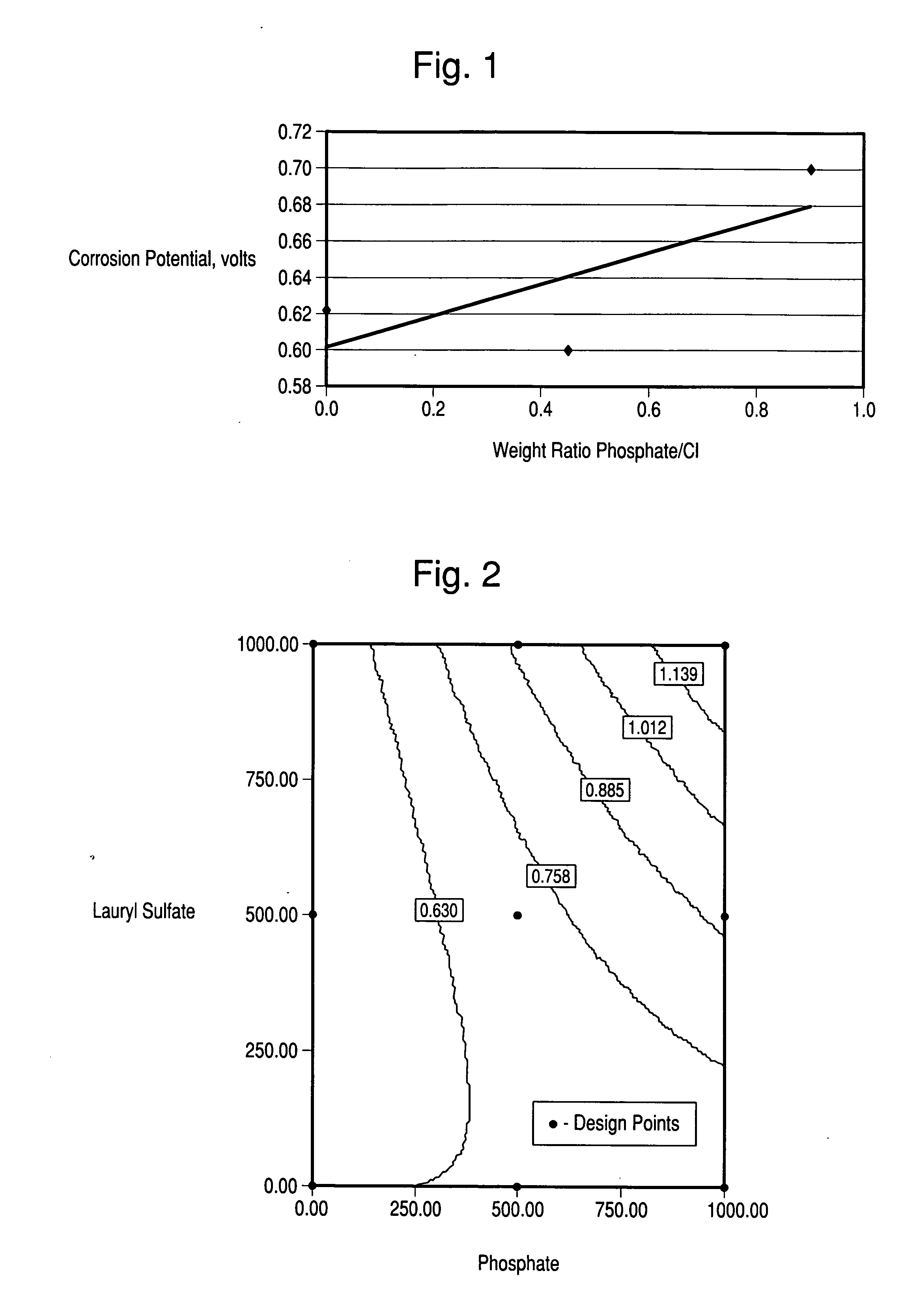Chlorine dioxide based cleaner/sanitizer
a chlorine dioxide and cleaner technology, applied in the field of chlorine dioxide compositions, can solve the problems of high operator skill, inability to manufacture and ship chlorine dioxide gas under pressure, and high cost of generation equipment, and achieve the effect of reducing the corrosive nature of chlorine dioxide solution and inhibiting metal corrosion
- Summary
- Abstract
- Description
- Claims
- Application Information
AI Technical Summary
Benefits of technology
Problems solved by technology
Method used
Image
Examples
example 1
[0077] Tablet formulations were made according to the tables below. Table 1 displays ingredients for a tablet composed of a metal chlorite such as sodium chlorite, a halogen such as sodium salt of dichloroisocyanuric acid, an acid other than hydrogen phosphate being sodium acid sulfate and a phosphate being sodium dihydrogen phosphate. A second tablet composed of a metal chlorite, an acid and a phosphate is disclosed in Table 3.
[0078] In both cases, the tablets were prepared using specific desired amount of each ingredient as follows: anhydrous sodium dihydrogen phosphate (>99.0% NaH2PO4) obtained from Sigma-Aldrich Chemical Co., of St. Louis, Mo. was dried at 90 degrees C. It was subsequently determined that drying at 180 degrees C. resulted in improved stability of tablets prior to immersion in water. Other ingredients were dried as described in U.S. Pat. No. 6,699,404. The desired amount of each ingredient was weighed and the ingredients were mixed and pressed into a tablet, and...
example 2
[0084] Four sets of solutions were prepared by dissolving a single 1.5 gram size tablet of the formulation of Example 5 of U.S. Pat. No. 6,699,404 in 600 ml of deionized water. To each solution 210 mg of sodium bicarbonate (NaHCO3) was added. 379 mg and 758 mg of sodium dihydrogen phosphate (NaH2PO4) were added to the third and fourth solutions, respectively. The third and fourth solutions yielded nominally 500 ppm and 1000 ppm phosphate, respectively.
[0085] A corrosion analysis was conducted using test coupons of type 304 stainless steel obtained from Metal Samples Co., Munford, Ala. The corrosiveness of each solution was measured by determining the electrochemical potential necessary to initiate corrosion on each test coupon. The test coupons were attached to a variable DC voltage supply and immersed in the test solutions. A platinum electrode was used for counter electrode. The voltage between the electrodes was slowly increased until the onset of electrical flow. New 304 stainl...
example 3
[0087] Different concentrations of phosphate and lauryl sulfate were added to 200 ppm chlorine dioxide solution and corrosion potentials were measured as in Example 2. The data was fitted to a regression equation using a least squares method and FIG. 2 shows the corrosion potentials from that regression equation displayed as contour lines on a graph of the different concentrations of phosphate and lauryl sulfate in the chlorine dioxide solution. According to FIG. 2, lauryl sulfate had little beneficial effect (i.e., no change in corrosion potential), the surfactant, by itself, had little effect and phosphate alone increased corrosion potential from about 0.6 to about 0.7 volts. However, when the surfactant was combined with phosphate there was much greater positive effect than the sum of the two individual effects. The combination of 1000 ppm lauryl sulfate and 1000 ppm phosphate increased corrosion potential to about 1.2 volts, which is close to the corrosion potential of water.
[0...
PUM
 Login to View More
Login to View More Abstract
Description
Claims
Application Information
 Login to View More
Login to View More - R&D
- Intellectual Property
- Life Sciences
- Materials
- Tech Scout
- Unparalleled Data Quality
- Higher Quality Content
- 60% Fewer Hallucinations
Browse by: Latest US Patents, China's latest patents, Technical Efficacy Thesaurus, Application Domain, Technology Topic, Popular Technical Reports.
© 2025 PatSnap. All rights reserved.Legal|Privacy policy|Modern Slavery Act Transparency Statement|Sitemap|About US| Contact US: help@patsnap.com


